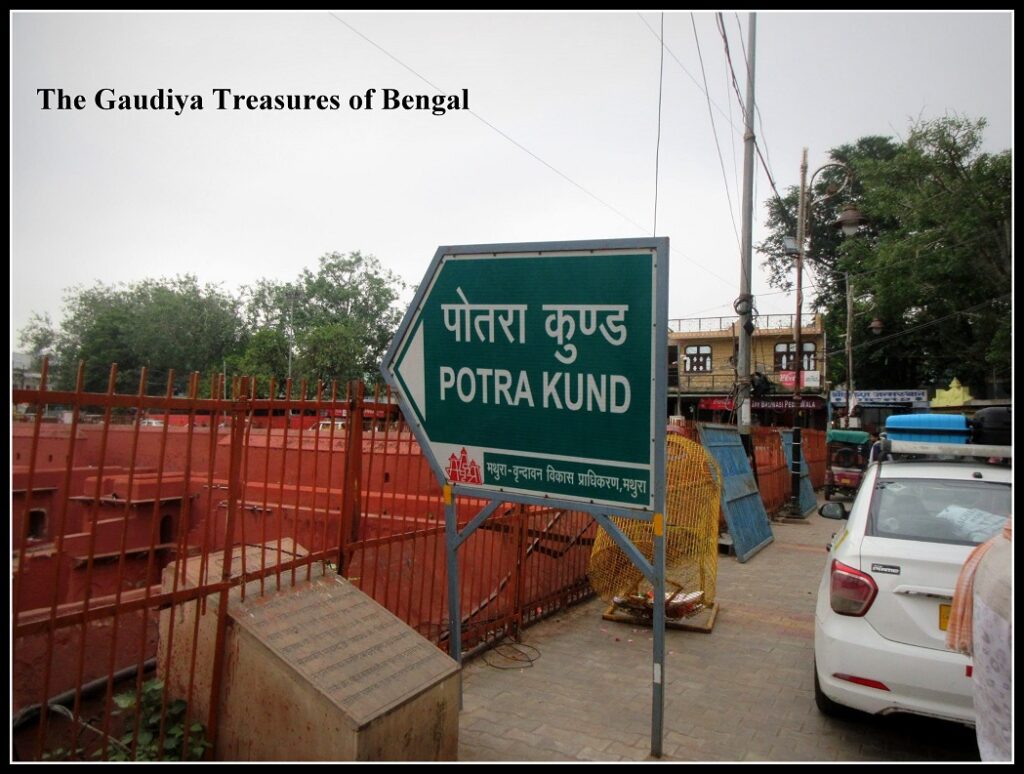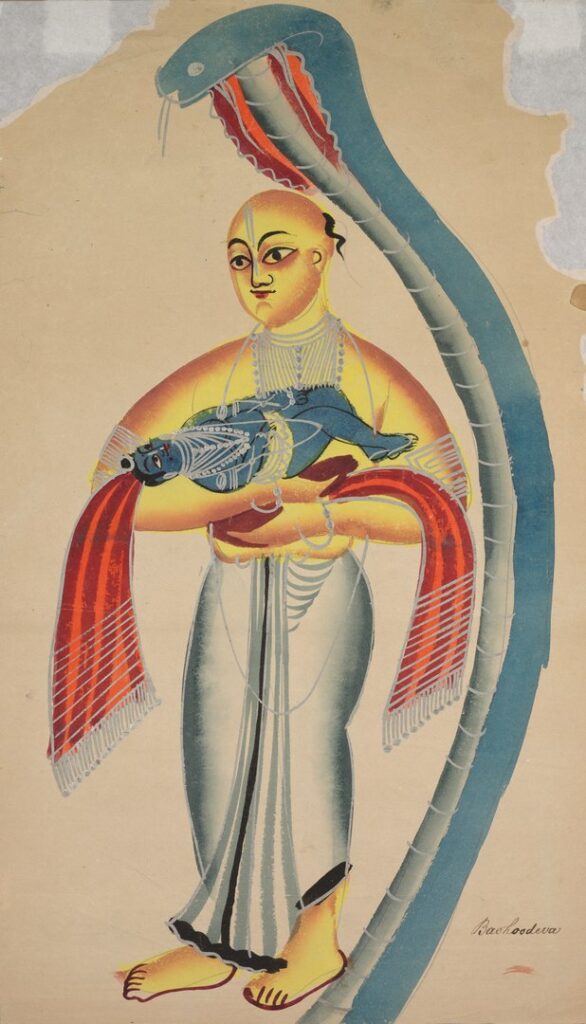
The foremost pilgrimage site of Mathura is the ‘Krishna Janmbhoomi temple’ or ‘Sri Krishna Janmasthan temple’ as it is sometimes referred to. It is built around the prison cell where Lord Krishna was born five thousand years ago. Krishna’s parents Devaki and Vasudeva were imprisoned in this cell by Kansa, the tyrannical brother of Devaki. The temple is said to have been originally built by Vajranabh, Krishna’s great-grandson, to commemorate the appearance of Sri Krishna. But it was later demolished by the invaders. Since then, the temple has been rebuilt and demolished numerous times over the past centuries. The present group of temples is a result of a major renovation project carried out in the 20th century. The temple compound comprises the impressive Keshava Deva temple, with the ‘garbha griha’ (sanctum sanctorum), and the Bhagavata Bhavan. Although the place might come across as ordinary to the casual eye, it is of paramount importance to a spiritual seeker. The birthplace of Krishna, the Supreme Lord, is completely spiritual and free from any traces of material contamination.
When Sri Chaitanya Mahaprabhu visited Sri Krishna Janmasthan temple, 500 years ago, He sang and danced in ecstasy beholding the deity of Keshava deva. People were awestruck to witness His loving ecstatic sentiments for the divine. The people also began chanting and dancing with Him and there was a wonderful uproar. The priest who was serving Sri Keshava deva then presented a garland to Chaitanya Mahaprabhu.
premanande nache, gaya, saghana hunkara
prabhura premavesha dekhi’ loke chamatkara
(Chaitanya Charitamrita, Madhya, 17.157)
–
When Sri Chaitanya Mahaprabhu danced (before Keshava deva) in loving ecstasy while repeatedly chanting the holy names of Hari and Krishna, the people became astounded witnessing His divine love.
Bhagavata Bhavan boasts five shrines. The main shrine is that of Sri Radha and Krishna. The path that circumambulates this altar contains all eighteen thousand verses of Srimad Bhagavatam inscribed in copper. To the right are worshiped the deities of Jagannath, Baladeva, and Subhadra. A deity of Sri Chaitanya Mahaprabhu stands on a different platform facing them. To the left are worshiped the deities of Lord Rama, Lakshmana, and Sita. Hanuman stands on a separate platform facing them. There are also deities of Lord Shiva (Keshaveswara) and Durga devi in the temple compound. Other constructions in the Bhagavata Bhavan include an Ayurveda Bhavan, an International guest house, shops, a library, and an open space for performance. The holy ambiance and purity of the temple arouse one’s eternal relationship with the divine.

Sri Keshava deva temple was built by Ramakrishna Dalmia in memory of his mother Jadiadeva Dalmia. The construction of this temple started in June 1957 and was inaugurated in September 1958 by Hanuman Prasad Poddar. The breathtaking white marble deity of Lord Keshava deva enchants and steals the hearts of the devotees. The original Keshava deva deity was installed at this place by King Vajranabh. It was however moved from Mathura to a village called Rajdhani and from there it was moved elsewhere. No one is aware of the deity’s present whereabouts.
The Garbha Griha has the appearance of a prison cell. This is where Lord Krishna is accepted to have been born 5000 years ago. A marble pavilion and an underground prison cell were built on the site with a spacious veranda. The interior is decorated with beautiful portraits of Vasudeva carrying baby Krishna across the Yamuna, a portrait of four-handed Krishna giving darshan to Vasudeva and Devaki, and demigods offering prayers unto Krishna with their folded hands. A temple devoted to the eight-handed goddess Yogmaya stands nearby.
On the southeast of the Janmasthan temple is a large and deep stepped water tank known as Potra Kunda or Pavitra Kunda. This is said to be the place where Krishna’s baby clothes were washed by Devaki. The word ‘Potra’ means clothes. Mahadji Scindia constructed the tank stairs in 1782. In 1850, his descendants repaired them. The tank is connected via underground pipelines to river Yamuna which flows about 3 Kms away. The water from Potra Kunda is believed to cleanse one of his/her sins. That is why it is particularly crowded during festivals and holy occasions.
Glorification of Sri Krishna Janmasthan
Skanda Purana says –
Japopavasa nirato mathurayam sadanana
Janmasthanam samasadya sarva papaya pramuchyate
–
O Karttikeya! One who, while chanting Japa and fasting, reaches the birthplace of Krishna is absolved from all his sins.
Padma Purana says –
Kartikke janma sadane kesavasya ca ye narah
Sakrt pravistah sri krsnam te yanti param avyayam
–
Those who once enter Krishna’s birthplace during the month of Kartik (October-November) are successful in attaining supreme, indestructible Krishna.
Adi Varaha Purana says –
Pradaksini krta tena sapta dvipa vasundhara
Pradaksini krto yena mathuqrayam tu kesavah
–
The person who circumambulates Keshava deva in Mathura has achieved the piety of circumambulating the seven islands of the earth.
Birth of Sri Krishna – Appearance of the Supreme Lord
Devaki and her husband Vasudeva were imprisoned by Kansa (Devaki’s oppressive brother) when Kansa learned that their eighth son would be the cause of his own death. Kansa was a tyrant who imprisoned the couple with the intention of killing his sister’s sons one by one. Kansa made alliances with other demoniac kings and unleashed a reign of terror. No one could dare speak against Kansa or his monstrosities. When Devaki became pregnant for the seventh time, Sri Balarama, who is a plenary expansion of Krishna, appeared in Devaki’s womb. Devaki was jubilant as she could perceive that Lord Vishnu had taken shelter in her womb. At the same time, she was morose fearing that Kansa would kill the baby soon after birth. Krishna, the supreme Lord, then instructed His yogamaya potency to move Lord Balarama from Devaki’s womb to the womb of Rohini. Rohini was one of Vasudeva’s wives who was living in Vrindavan out of Kansa’s fear. Krishna declared that Lord Ananta would be renowned as ‘Balarama’ or ‘Sankarshana’ after His divine appearance. Thus, placing Devaki and Rohini devi in Yoga-Nidra, Yogamaya shifted Lord Balarama from Devaki’s womb to Rohini’s womb. As a result, people assumed that Devaki’s seventh pregnancy was a miscarriage.

Thereafter Lord Krishna, in His original form along with all His potencies, entered the heart of Vasudeva. He was then transferred to the heart of Devaki. Krishna was not put into Devaki’s body through seminal discharge. Krishna, being the Supreme Lord, is not subject to the laws of material nature. The presence of Krishna in her body enhanced Devaki’s transcendental beauty. Seeing her effulgence Kansa at once concluded that the Supreme Lord had taken shelter in Devaki’s womb. At that time, demigods headed by Lord Brahma appeared in Kansa’s house and they offered their earnest prayers to the Supreme Lord who was resting in Devaki’s womb.
Janma karma ca me divyam, evam yo vetti tattvatah
Tyaktva deham punar janma, naiti mam eti so arjuna
(Bhagavad Gita 4.9)
–
One who knows the transcendental nature of my birth and activities is not born again in this material world, but instead attains my eternal spiritual abode, O Arjuna.
The Supreme Lord is not forced to appear in this world like an ordinary person but instead appears out of His own sweet will. When the time was ripe for the Lord to appear, the alignment of the constellations became very auspicious, and the influence of the star Rohini was dominant. Auspicious signs of good fortune, peace, and prosperity pervaded all directions. The denizens of heaven showered flowers from the sky. They sang and danced in ecstasy. At that auspicious moment, on the eighth day of the waning moon, Sri Krishna, the Supreme Lord appeared from the womb of mother Devaki, just as the full moon rises over the eastern horizon.
Vasudeva saw his son decorated with the marks of Srivatsa and holding a conch, club, disc, and lotus with His four hands. He saw His son dressed in yellow silk, wearing a jeweled necklace of Kaustubha stone, wearing a vaidurya helmet, earrings, ornaments, and gleaming with bright effulgence. Vasudeva was astounded to behold the beauty of his child. He wondered how a newborn could be so ornamented. Vasudeva realized that the Supreme Lord had appeared as his son and he offered his prayers unto Him. Although Vasudeva was shackled in Kansa’s prison, he imagined donating thousands of ornamented cows in charity to the brahmanas. Vasudeva and Devaki were scared that Kansa would try to kill Krishna as soon as he heard the news. Krishna revealed to Vasudeva and Devaki that they were the incarnations of Prsni and Sutapa who had previously performed severe austerities with the only desire of having the Supreme Lord as their child. Hence the Lord reciprocated their prayers by accepting them as His parents millennium after millennium. The Lord had previously appeared as Prsnigarbha, the son of Prsni and Sutapa. He had subsequently appeared as Upendra, the son of Aditi and Kashyapa, and now He has appeared as Krishna, the son of Devaki and Vasudeva.
Vasudeva carries Krishna to Gokula
Krishna then concealed His divine features and turned Himself into an ordinary child having two hands. He ordered Vasudeva to immediately carry Him to Gokula and exchange Him for the daughter of Yashoda. Yashoda’s daughter had also taken birth about the same time as Krishna. She was the manifestation of Krishna’s Yogmaya potency. By the dint of Krishna’s prowess, all the residents of Kansa’s palace, especially the doorkeepers, were put into a deep slumber. All the palace doors unlocked although they were shackled with iron chains. Although it was the middle of the night, Vasudeva could see everything very clearly. It was raining heavily, yet not a drop of rain fell upon Vasudeva or Krishna, who were protected by the hoods of Ananta Sesha.

On reaching the shore of Yamuna, Vasudeva saw that the river was roaring with furious waves. The river however parted itself for Vasudeva, providing him a safe passage to cross over to Gokula. Reaching Nanda Maharaja’s palace in Gokula, Vasudeva found everyone asleep. He silently exchanged Krishna with the newly born baby girl of Yashoda. Then, carrying the baby girl along with him, he returned to Kansa’s palace and put the shackles back on himself so that Kansa would not suspect him. Once Vasudeva returned, the doors and palace gates locked automatically. When Kansa heard that Devaki’s eighth child was born, he hurried toward the prison cell. Devaki pleaded with Kansa not to kill her daughter. She assured Kansa that a female child will not become the cause of his death and that he should spare her life. But Kansa valued his own life above all familial relationships. He picked up the little girl with the intention of killing her. Just then, the girl slipped out of his hands and assumed the form of Maa Durga. She identified herself as Vishnu’s younger sister. Her eight arms were adorned with bow, lance, arrows, sword, conch, disc, club and shield. She chastised Kansa for his cruelty and informed him that the child who was destined to kill him has already taken His birth elsewhere. The goddess hence asked Kansa to release Devaki and Vasudeva. Hearing these words, Kansa became overwhelmed with fear and anxiety.
How to Reach Krishna Janmasthan
The Krishna Janmbhoomi temple is situated at Deeg Marg, Near Deeg Gate Chauraha in Mathura. It is located 2 Kms from the Mathura junction railway station. Sri Krishna Janmasthan temple is heavily fortified and it towers above all the other buildings of Mathura. All visiting pilgrims are searched at the entrance. No electronic items like cell phones or cameras are allowed beyond the checkpoint.